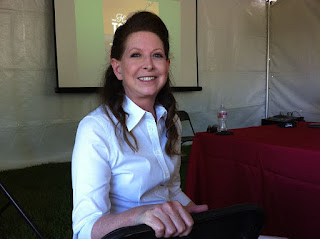Amy Goldman is the author of the new book The Melon. Her other books include The Heirloom Tomato and The Compleat Squash. She is a gardener, an artist, and an advocate for seed saving.
Q:
How did you come up with the idea for The Melon, and how long did it take you
to research and write the book?
A:
Melons are a lifelong love and calling. Ten years after my first melon book was
published (Melons for the Passionate Grower (2002)), I decided to write a new
one, because I’d grown as a gardener and learned a lot more.
The new book is
more well rounded, more comprehensive, more up to date. It took me nine years –
nine growing seasons’ worth of photo shoots and data collection – until I felt
I had a representative sample of the diversity that exists in cultivated melon.
The writing itself took about two years.
Q:
What did you learn in the course of your research that especially surprised
you?
A:
I took advantage of a bonanza of research findings that informed my thinking on
crop history. This includes considerable new evidence from archeological,
iconographic, and literary records, as well as recent phylogenetic studies.
The
Cucurbitaceae or gourd family of plants (which includes melon and watermelon)
most likely originated in Asia in the Late Cretaceous period (over 70 million
years ago).
Various lineages found their way time and again to different
continents by transoceanic long-distance dispersal. Picture gourds afloat! Watermelon’s
more recent place of origin is in Africa; and the wild progenitor of melon has
been found growing in India.
The
writings of 19th century authorities also inspired me – I found friends across
the years and miles. I loved tracing the history of favorite melons.
My
collection of American seed catalogues allowed me to observe the ebb and flow
of popular varieties, to pinpoint introduction dates, and to peek into the mind
of 19th-century seed and nursery growers. I uncovered new information about
nearly all the melons and watermelons featured in the book.
Q:
How closely did you work with photographer Victor Schrager on the book, and
what do you think the photos add?
A:
Melons and watermelons are my favorite “fruit vegetables” (fruits of herbaceous
plants). No one could have done my homegrown beauties more justice than Victor
Schrager. It’s been an honor and an absolute joy to work side by side with him
on the book for so many years. He gives my passion for the subject matter
visual embodiment.
I
grow and harvest; clean, grade, and sort; and hand the melons off to Victor in
the barn studio so he can work his magic. Together we’ve created four books
(with two more in the works).
As
I explain in the book’s foreword, “Our wooden and marble props and backgrounds
designed for melon photography are showing their age and fraying at the edges,
but Victor remains amazingly fresh in his approach. The challenge for him has
always been to provide elements of surprise while celebrating the obvious. He
explains it’s like a wonderful pas de deux, a balance between aesthetics and
practicality. And the opposite of tricks and illusions, because you can see his
props and how he did it. It still boggles my mind.”
Q:
How did you select the recipes you include in the book, and do you have a
favorite?
A:
Melons are not just for dessert. I wanted to highlight their versatility in
cookery including salads and starters, mains, drinks, and sweets. Mindy Fox
created most of the recipes; Nate Auchter added a few. All are delicious.
Q:
What are you working on now?
A:
Victor Schrager and I have just started our eighth year of grow-outs and
photography for a book on heirloom peppers. With 99 percent of the photography
and data collection completed, I immerse myself in the research and writing.
Q:
Anything else we should know?
A:
We are simultaneously working on a new book on squash, pumpkins, and gourds.
--Interview with Deborah Kalb




No comments:
Post a Comment